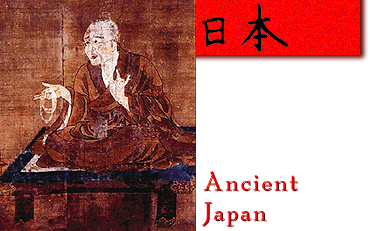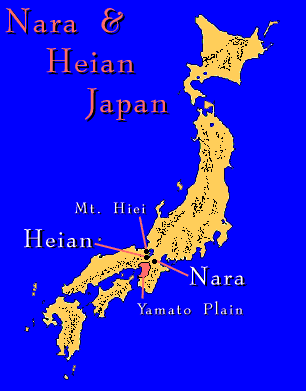



 |
profound change in Japanese government was the adoption of Chinese, particularly Confucian, models of government in Prince Shotoku's Seventeen Article Constitution . The reforms undertaken by Shotoku not only addressed the internal problems the Yamato court was faced with, they also dramatically changed Japanese history. |
| The various Japanese states are named for the regions in which the capital was located. In 710, the capital was moved north to Nara. It was a carefully planned city laid out on a rigorous grid after the Chinese capital of Chang-an. Meant to be a permanent capital, it was moved again only eighty years later. |
| Japan during the Nara period, however, was primarily an agricultural and village-based society. Most Japanese lived in pit houses and worshipped the kami of natural forces and ancestors. Building a capital city on the model of a Chinese capital produced a dramatic alienation of Japanese aristocracy from the Japanese population. In this region of villages, pit-houses, and kami -worship, grew up a city of palaces, silks, wealth, Chinese writing and Chinese thought, and Buddhism. The Nara capital represents the definitive break of the Japanese aristocracy from their roots in the uji . |
| The most influential cultural development in the Nara was the flowering of Buddhism. Several schools of Buddhist thought imported from T'ang China made their way to the capital city. For the most part, Buddhism was a phenomenon of the capital city well into the Heian period. However, the vitality of Buddhism at this time led to a closer integration of Buddhism with Japanese government. The Nara emperors in particular deeply reverenced a Buddhist teaching called the Sutra of Golden Light ; in it, Buddha is established not only as a historical human being but also as the Law or Truth of the universe. Each human has reason, prajna , with which to distinguish good from bad. The life of reason, then, is the beginning of a proper Buddhist life. Politically, the sutra claimed that all human law must reflect the Ultimate Law of the universe; however, since law was a phenomenon of the material world, it was subject to change. This gave Japanese monarchs a moral basis for their rule and a justification for adapting rules and laws to changing circumstances. |
| The devoutness that the Nara emperors held for Buddhism guaranteed its rapid and dramatic expansion into Japanese culture. Although Buddhism entered Japan in 518, it was during the Nara period that it became a solid presence in Japanese culture. |
